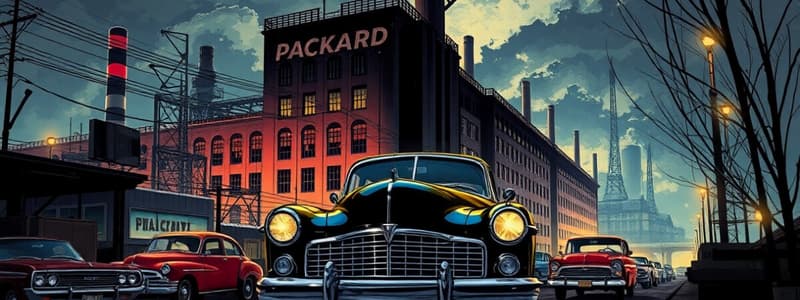Podcast
Questions and Answers
Which of the following factors best exemplifies how the Packard plant became a 'symbol of Detroit's decline'?
Which of the following factors best exemplifies how the Packard plant became a 'symbol of Detroit's decline'?
- Its transformation into a hub for technological innovation that was later outcompeted by Silicon Valley enterprises.
- Its abandonment, decay, and association with urban blight, representing the economic challenges faced by the city. (correct)
- Its use as a training center for unemployed workers transitioning to new industries, reflecting a shift in the labor market.
- Its conversion into affordable housing units, showcasing Detroit's efforts to address homelessness and poverty.
Flashcards
Packard Automotive Plant
Packard Automotive Plant
Main production facility of Packard Automotive, opened in 1903 in Detroit.
Pierce Arrow & Peerless
Pierce Arrow & Peerless
Luxury car brands that Packard competed with in the early 1900s.
Cadillac
Cadillac
GM's luxury car brand that surpassed Packard in sales by 1950.
WWII Production
WWII Production
Signup and view all the flashcards
Studebaker
Studebaker
Signup and view all the flashcards
Packard Plant Closure
Packard Plant Closure
Signup and view all the flashcards
Fernando Palozello
Fernando Palozello
Signup and view all the flashcards
Study Notes
- The Packard Automotive Plant in Detroit, Michigan, was a major employer and production center for over 50 years.
- The plant was the main production facility for Packard Automotive, opening in 1903.
- Over time, the plant expanded to cover 40 acres, totaling 3.5 million square feet and stretching over half a mile long.
- The plant employed as many as 40,000 workers.
- Notable models produced included Packard's 4, 6, 8, and 12 cylinder models.
- Packard competed with Pierce Arrow and Peerless in the luxury car market during the early 1900s.
- Packard outlasted its main competitors, Pierce Arrow and Peerless.
- Cadillac and Lincoln became major competitors as the luxury car market changed.
- Packard adapted by producing lower-cost cars during the depression, while maintaining its Detroit plant as its sole assembly location, reducing expenses and boosting competitiveness.
- From 1942 to 1945, the plant manufactured plane and boat engines for World War II.
- Packard fell behind GM in design during the late 1940s.
- In 1950, Cadillac surpassed Packard as the top-selling luxury car company.
- Packard produced modern designs like the Packard Clipper and Packard Partition in an attempt to remain competitive.
- Increased competition, the purchase of Studebaker, and the lack of war production deals led to Packard's decline.
- In 1958, the Studebaker-Packard Corporation closed the plant.
- The merged company ceased operations eight years later.
- The Packard plant was used by various companies for storage.
- Unoccupied sections of the plant began to deteriorate, resulting in criminal activity.
- The city of Detroit planned to demolish the plant in the late 1990s, budgeting $4 million for the project.
- Demolition began in early 1999 but was halted due to a court order from the previous owners.
- The previous owners regained control by fulfilling unpaid tax obligations.
- By 2010, the plant was completely abandoned.
Decline and Abandonment
- The plant experienced vandalism, scrapping, and weathering due to abandonment.
- The plant became a symbol of Detroit's decline.
- In 2013, Fernando Palozello purchased the plant for just over $400,000, planning a mixed-use redevelopment.
- The redevelopment project never materialized.
- After seven years, the plant was put up for sale.
- The city seized and demolished small portions of the plant, but most of it remains.
- In 2019, the Packard plant bridge collapsed, symbolizing its decline.
- The cost of demolishing the complex and the abundance of vacant land in Detroit contribute to the uncertainty of its future.
Studying That Suits You
Use AI to generate personalized quizzes and flashcards to suit your learning preferences.

